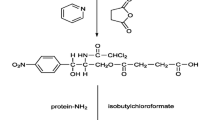Summary
A HPLC method is used for analysis of chloramphenicol residues in meat. The theoretical limit of detection is 0.01 ppm when the yield over all steps is 71%.
Zusammenfassung
Es wird ein HPLC-Verfahren beschrieben, mit dem Chloramphenicol-Rückstände im Fleisch bestimmt werden können. Bei Wiederfindungsraten von 71% beträgt die theoretische Bestimmungsgrenze 0,01 ppm.
Similar content being viewed by others
Literature
Encyclopedia of industrial chemical analysis. HerausgeberF. D. Shnell undC. L. Hilton, Vol. 5, S. 506, Interscience Publ., New York, London, Sidney 1967.
Die Antibiotica, HerausgeberR. Brunner undG. Machek, Vol. 2, S. 167, Verlag H. Carl, Nürnberg 1962.
M. Margosis, J. Chromatog.47, 341 (1970).
H.-L. Jüntgen, Ergebnisse von Querschnittuntersuchungen auf Arsenikalien, Nitrofurane, Sulfonamide und Chloramphenicol im Fleisch schlachtbarer Haustiere, Diss. Tierärztl. Hochschule Hannover 1973.
G. Vigh undJ. Incedy, J. Chromatog.129, 81 (1976).
H. Engelhard, Hochdruck-Flüssigkeits-Chromatographie, Springer-Verlag, Berlin, Heidelberg, New York 1975.
Author information
Authors and Affiliations
Rights and permissions
About this article
Cite this article
Rüssel, H.A. Über die Bestimmung von Chloramphenicol in tierischen Geweben durch HPLC. Chromatographia 11, 341–343 (1978). https://doi.org/10.1007/BF02314773
Received:
Accepted:
Issue Date:
DOI: https://doi.org/10.1007/BF02314773




